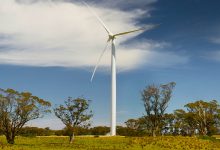The NSW government is busily announcing new renewable energy zones and calling for interest from wind, solar and storage developers to meet the capacity needed to replace the state’s ageing coal fleet.
The first two REZs are in the central west (around Dubbo), and in New England (Barnaby Joyce’s electorate), and they elicited an enthusiastic response. But it also turns out that the Goulburn district – in the heart of federal energy minister Angus Taylor’s electorate of Hume – is also highly suitable to be a designated REZ.
The reasons for this are many: Close proximity to a big load in Sydney (170 km); a very good solar resources (Figure 1); excellent wind resources (Figure 2); extensive pumped hydro energy storage opportunities (Figure 3), and good existing transmission (Figure 4). (All figures are at end of story).
The region is also directly in the path of transmission connections between Sydney & Melbourne and Sydney & Snowy 2.0, and most of the electorate of Hume (figure 5) has excellent prospects to participate in the renewable energy industry.
That makes the Goulburn district (and the electorate of Hume) is one of the most prospective Renewable Energy Zones in Australia.
Power from wind and solar farms in the Goulburn district can travel directly northeast to Sydney or can be transferred by a high voltage powerline to Mount Piper near Lithgow and thence to Sydney.
Large-scale private investment in a Goulburn/Hume REZ could result in 10-30 gigawatts of wind and solar PV (and transmission and storage) over the next 10-20 years.
This investment would amount to $15-50 billion.
A significant fraction of this investment would be spent in the Goulburn district to build and operate and (periodically) refurbish solar farms, wind farms, roof-mounted solar PV systems, new power transmission, pumped hydro energy storage and battery storage.
Such large-scale investment is a major economic opportunity for the Goulburn district.
For context, Australia is currently installing move than 6 Gigawatts of solar and wind per year with a value of about $8 billion per year.
Local jobs would be created in approvals, road construction, transport, land preparation, earth moving, solar panel mounting, turbine erection, electrical connections, project management, operations & maintenance and many others.
The renewable energy industry is installing net new generation capacity globally (mostly wind and solar PV) at a rate that is 5 times faster than the fossil and nuclear industries combined. In Australia, nearly all new generation capacity is wind and solar PV, because it is cheaper than new coal, gas or nuclear.
Australia is installing more than 200 Watts per person per year of new solar and wind power, which is 4-5 times faster than the EU, Japan, China or the USA: https://reneweconomy.wpengine.com/australia-deploying-new-renewables-at-ten-times-global-average-11689/
However, lack of new transmission threatens to throttle this industry. Because Hume is close to Sydney it would be relatively quick and cheap to augment transmission to Sydney.
Goulburn/Hume is already participating in the renewable energy industry via solar and wind farms.
However, there is far larger opportunity in future years if Governments provide assistance.
What has to happen to unlock this opportunity?
The NSW and Federal Governments could designate Goulburn/Hume as a renewable energy zone. The Federal and State Governments could facilitate construction of additional transmission to allow movement of solar and wind power from Goulburn/Hume into Sydney and thereby unlock private investment into Gigawatts of new solar and wind farms.
Federal and State members of Parliament, and local Councils, could endorse and support a Goulburn/Hume REZ. And a detailed study of the enormous potential for jobs and investment could be commissioned.
Professor Andrew Blakers is based at the research school of electrical, energy and materials engineering at the Australian National University in Canberra.















